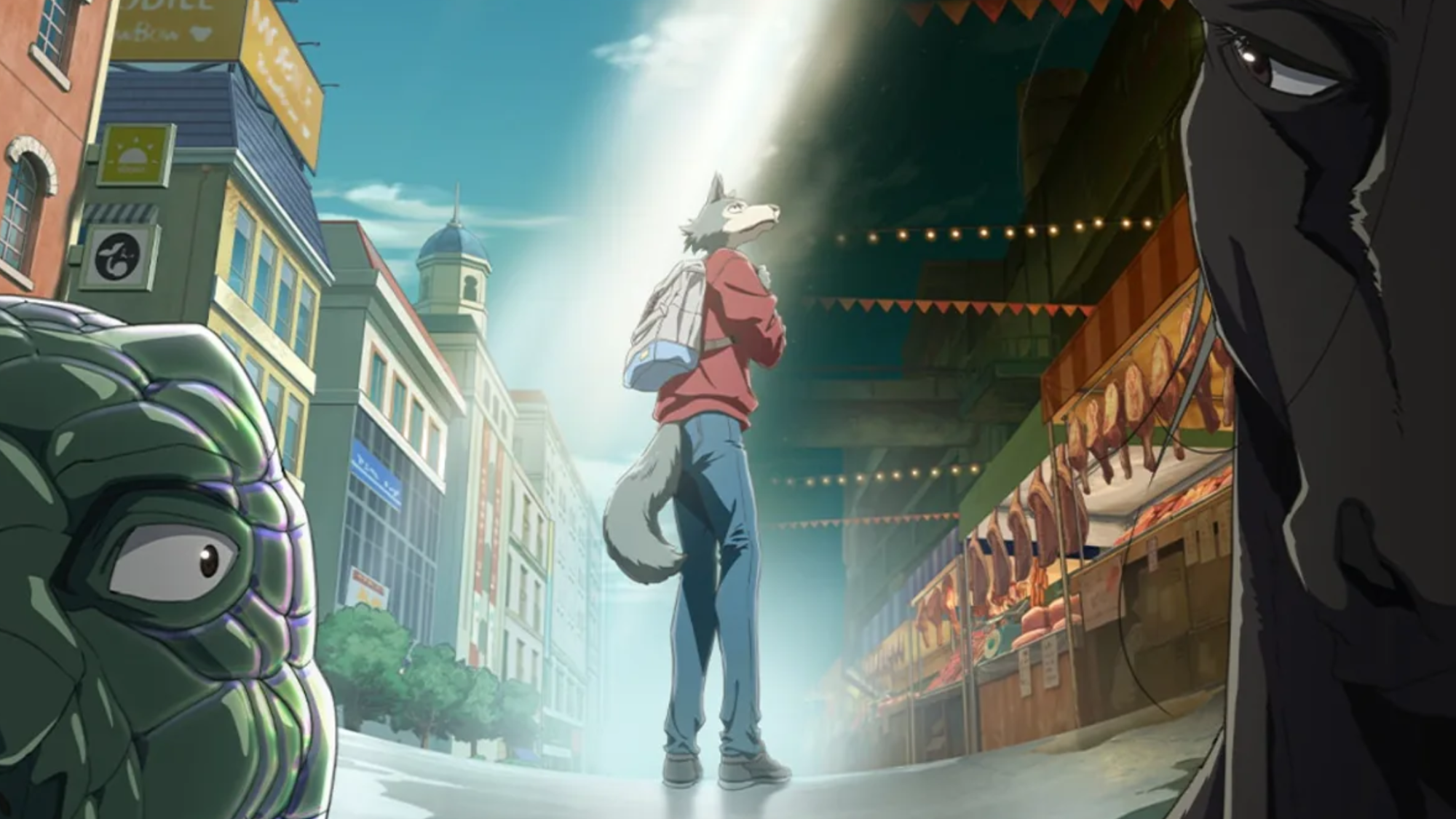In a world of predator and prey, Netflix’s Beastars examines societal prejudice, identity, and self-acceptance, creating a compelling and complex world against the backdrop of a divided society. Taking place in a modern world of civilized, anthropomorphic animals, Beastars focuses on the cultural divide between carnivores and herbivores, where eating meat (which always comes from other anthropomorphic animals) is strictly illegal.
Videos by ComicBook.com
Beastars was serialized in Weekly Shōnen Champion from 2016 to 2020, culminating in 22 volumes. Its anime adaptation by Studio Orange, which gained international acclaim through Netflix, debuted in 2019, followed by a second season in early 2021. With the final season set to premiere in two parts, with part 1 starting December 5, 2024, what can fans expect from the upcoming series after the previous season’s high-stakes and emotionally charged conclusion?
The following will not include any manga spoilers.
Beastars Season 3 Is the Culmination of the Anime to This Point
The final season of Beastars will bring the characters’ journeys to an end, exploring themes of identity, pride, family, and the ever-shifting balance between prey and predator. Legoshi will face his struggle for self-acceptance while deepening his relationship with Haru. Louis will continue to wrestle with his identity as a former Shishigumi leader and a symbol of unity, caught between his past and future.
Season 3 will introduce new characters, including the current Beastar—a figure who unites carnivores and herbivores—who will further challenge the dynamics, particularly for Louis and Juno, who once vied for the title. The final season promises a powerful and impactful conclusion, drawing on the growth, revelations, and challenges built throughout the series, including key developments from the first two seasons.

Season 1 Explores Insecurities, Power, and Desire
Beastars begins with the shocking murder of Tem, a kind-hearted alpaca, who is eaten by an unknown carnivore late at night at Cherryton Academy, a co-ed boarding school for both carnivores and herbivores. This brutal act stirs growing tensions among the students, as eating meat is considered one of the most heinous crimes in their society. In this world, herbivores live in constant fear of being killed, while carnivores are often treated as social pariahs, struggling with their instincts every day.
At the center of Beastars is Legoshi, a socially awkward, calm, and soft-spoken gray wolf who was friends with Tem, an alpaca he met in the drama club. The drama club is one of the few places at Cherryton Academy where herbivores and carnivores collaborate and work together. Legoshi’s struggle begins when he nearly kills Haru, a dwarf rabbit, one night, fighting an uncontrollable urge to kill her. This sparks his internal battle between desire and restraint. As Legoshi explores his feelings for Haru, he starts to question whether his feelings are driven by his violent instincts or something deeper. His journey is one of self-discovery and coming to terms with his strengths and insecurities.
Louis, the confident and seemingly arrogant red deer, hides his insecurities rooted in his painful past as illegal livestock for carnivores in the Black Market. In this taboo area, carnivores go to purchase illegal goods, including meat. His performance as Adler, the Grim Reaper, an iconic symbol of coexistence and prosperity, offers him a chance to gain power and respect, something he longs for to escape his past.
However, Louis endures extreme physical pain, pushing himself to the point of hospitalization to maintain his perceived status. Haru, a dwarf rabbit, feels weak and defenseless because of her species and size. Her insecurities lead her to use sexual promiscuity as a coping mechanism, attempting to gain power and equality. This complex relationship with her own identity adds another layer of tension, particularly with Legoshi.
RELATED: The Best Anime TV Series to Stream on Netflix

Beastars Explores Its Characters’ Struggles
All the main characters—Legoshi, Haru, and Louis—struggle with their insecurities. Haru and Louis, as herbivores, both feel weak and vulnerable in a world where carnivores dominate. However, they react differently to their circumstances. Louis hides his pain behind arrogance and a strong public persona, while Haru uses her sexuality to compensate for her physical fragility. Legoshi, meanwhile, faces the challenge of restricting his predatory instincts with his desire to protect those he cares about. His internal conflict centers on what it means to be powerful—whether to use his strength to protect or to harm others.
At the heart of Beastars is exploring predatory instincts versus personal morality. Legoshi’s internal struggle—whether to kill or protect—is a central theme. The boundaries between predator and prey are blurred as the characters grapple with their desires, fears, and the societal expectations placed upon them. Beastars dives into deeper themes of power, strength, morality, and personal growth through these complex character dynamics.
Throughout Season 1, Legoshi discovers the Black Market, a dark underground world where herbivores sell their body parts to passing carnivores. As he navigates this disturbing reality, he meets Gohin, a no-nonsense panda who becomes a mentor to Legoshi. Meanwhile, the rising tension escalates when Haru is kidnapped by the Shishigumi, a dangerous pride of lions and one of the four major criminal organizations that control the Black Market. Legoshi, with the help of Gohin, rescues Haru from the Shishigumi’s clutches. But when the boss of the Shishigumi is gunned down by Louis, his fate after the shooting is left uncertain.
Subsequently, Juno, a gray wolf and fellow student at Cherryton Academy, begins to develop feelings for Legoshi, which intensify as she becomes increasingly jealous of his relationship with Haru, believing that she and Legoshi are a better match due to being the same species. Additionally, it is revealed that Haru and Louis share a complicated relationship. Haru is deeply in love with Louis, but he cannot fully commit to her due to his betrothal to another deer, arranged by his overbearing and commanding adopted father. These two love triangles add further complexity to these animals’ emotional struggles in a world filled with fear and societal pressures.

Season 2 is All About Secrets, Revelations, and Mortality
Season 2 of Beastars begins with the revelation that Louis has been missing from Cherryton Academy for months, only to resurface as the new boss of the Shishigumi, a pride of lions operating in the Black Market. Louis assumes the role as a form of public relations for the pride, gaining their respect but at a cost. To solidify his position, he is forced to eat meat. Meanwhile, Haru and Legoshi grow closer, and Legoshi finally confesses his love for her.
Legoshi, now training under Gohin, discovers that Riz, a seemingly friendly and lovable brown bear from the drama club, is the one who murdered Tem. This revelation exposes the darker layers of Riz’s character and the effects of the mandatory medicine for bears to suppress their growth, which has adverse side effects on their mental state. Riz stopped taking the medicine, believing it allowed him to form a closer bond with Tem, but his delusion led him to attack and kill his friend. Legoshi embarks on rigorous training to face Riz, including an incident where he eats a bug and comes to a profound realization about the value of life.
The tension culminates in a climactic fight between Legoshi and Riz. Initially, the battle occurs at Cherryton Academy, but they postpone the final confrontation until New Year’s Eve. Meanwhile, Louis faces a life-threatening ultimatum from Ibuki, a Shishigumi lion who has grown protective of him. Ibuki demands that Louis either kill him or risk being killed. Ultimately, Free, another member of the Shishigumi, intervenes and kills Ibuki, warning Louis to stay away from the Black Market.

Season 2 Has a Fateful Confrontation
At the showdown between Legoshi and Riz, Legoshi is nearly defeated until Louis intervenes, offering Legoshi his right foot to eat and awaken his full strength. This act, symbolic of sacrifice and trust, gives Legoshi the power to hold his own. As the fight ends, Pina, an arrogant Shishigumi, escapes from Riz’s captivity and contacts the police. Riz, accepting defeat, surrenders. Both Legoshi and Riz are arrested, but Legoshi is later released early. Meanwhile, Louis begins his recovery after his time with the Shishigumi.
Season 2 of Beastars focuses on unmasking hidden truths and the personal transformations that follow as each character grapples with the weight of their secrets and the impact of revealing them. Legoshi’s journey is deeply rooted in the theme of revelation as he uncovers the shocking truth about Riz being Tem’s murderer, forcing Legoshi to confront his instincts and morality.
The burden of secrecy marks Louis’s story as he assumes the role of Shishigumi’s boss. Louis’s time in the Black Market exposes the dualities of his character—his desire for power and respect versus his inability to reconcile with his herbivore nature. His bond with Ibuki, a lion who knows Louis’s secret and ultimately sacrifices himself for Louis’s future, underscores the devastating consequences of living with hidden truths.
Riz truly embodies the destructive power of secrets. His cheerful demeanor masks a dark truth: he murdered Tem in a fit of unchecked predatory rage. Riz’s attempts to rationalize the murder as an act of friendship reflect his delusional coping mechanism. Pina, the self-assured Dall sheep, plays a unique role in the season’s thematic exploration of secrets. While his outward confidence and charm suggest he has nothing to hide, Pina’s fearlessness is tested when he uncovers Riz’s crime. Pina’s public confrontation with Riz, disguised as a dramatic monologue during a performance, showcases his bravery in using the truth as a weapon. Whereas many characters are weighed down by their secrets, Pina’s approach to exposing lies contrasts sharply.
Haru and Juno both experience revelations tied to their relationships with Legoshi. Haru grows closer to Legoshi, learning more about his complex inner world and the depth of his feelings for her. Meanwhile, Juno’s evolving understanding of Haru reveals a newfound respect for her rival. At its core, Season 2 of Beastars examines the consequences of hidden truths and the liberating, though often painful, process of bringing them to light.
The final season of Beastars will conclude the characters’ arcs, exploring themes of identity, growth, and the ongoing struggle between prey and predator. As the animals confront their struggles and the complex dynamics of their world, the series promises an impactful and emotional conclusion that will tie together the relationships and conflicts developed over the previous seasons.







